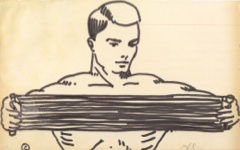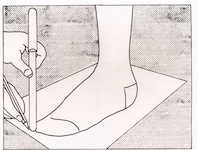Lichtenstein’s Whaam! (1963)

Top: Roy Lichtenstein, Whaam! (1963) Oil and magna on canvas. Tate Modern, London
Bottom: Original comic source of Whaam! discovered by David Barsalou in 2000.
Click image to enlarge.
Roy Lichtenstein has had many detractors. One of them, David Barsalou, searches for the orginal comics which inspired them and publishes them online. It's a useful resource. Below is the origin of Whaam! though Lichtenstein’s painting is perhaps 100 times larger.

Top: Lichtenstein, Whaam! (1963)
Bottom: Michelangelo, Creation of Adam (c. 1508-12)
Click image to enlarge.
What he did was recognise a similarity in design between the strip and Michelangelo’s Creation of Adam because the flying plane on the left, like Michelangelo’s flying God, is painting the explosion of another plane which, like Adam, is an image of himself. If the Creation is flipped horizontally - as in a mirror - both images point downwards at the same angle in exactly the same horizontal format. How do I know this for certain?

Top: Detail and diagram of Whaam! with photo of Lichtenstein
Bottom: Diagram of detail from Lichtenstein's Alka-Seltzer (1966)
Click image to enlarge.
The flames form a caricatural version of the artist’s face. There’s a black triangle for one eye and a curve formed by the yellow to suggest another. See diagram, top center. His "nose", as it was in life, is long and his black "mouth" is like a Nike whoosh. I have shown the process before in his 1966 drawing Alka-Seltzer. See images below and separate entry.
So Lichtenstein is an artist, after all. He’s painting his mind at the very moment of the painting’s own conception, Whaam! being the modern equivalent of Eureka!, an explosion of creative insight.1 And, being art, the image is full of further wisdom.

Lichtenstein's Whaam! (below) with detail next to detail of Leonardo da Vinci's Vitruvian Man, rotated.
Click image to enlarge.
The plane's tail cuts through the star, features not in the comic. In dividing the star, however naturally, the visible parts inside the black circle resemble the outstretched arms and legs of Leonardo’s Vitruvian Man, a symbol of man’s unity with everything. The head is above the wing, which is itself symbolic of imaginative flight, the body below. Its "head" is in the world of spirit, its "body" in matter. Lichtenstein’s pictures often derive from popular illustrations but are, when seen this way, quintessential poetry conveying visual philosophy and that’s what makes them art.
More Works by Lichtenstein
Notes:
1. There can be little doubt then that 30 years before Michelangelo's Creation of Adam was shown to include God inside the shape of a human brain, Lichtenstein already knew it. See "A Quick Guide to the Sistine Chapel".
Original Publication Date on EPPH: 01 May 2018. © Simon Abrahams. Articles on this site are the copyright of Simon Abrahams. To use copyrighted material in print or other media for purposes beyond 'fair use', you must obtain permission from the copyright owner. Websites may link to this page without permission (please do) but may not reproduce the material on their own site without crediting Simon Abrahams and EPPH.



